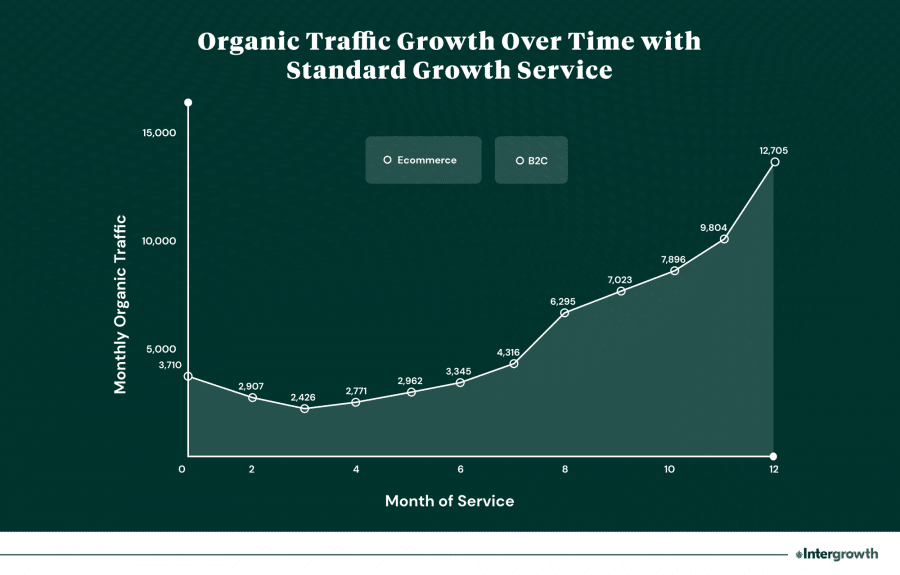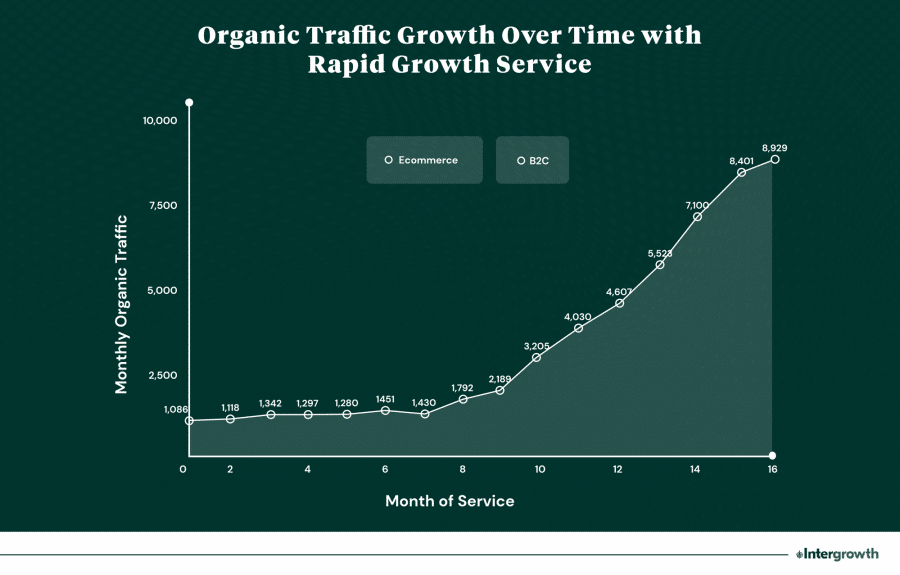It doesn’t matter if you have the greatest product or most incredible service in the world — unless you know how to market it, no one will know that it exists.
There are all sorts of traditional marketing techniques that you can use to get your products in front of your customers.
You can pay for radio, television, and print ads. You can put up billboards or mail out catalogs, flyers, and coupons. You can place ads on Google and Facebook.
But one of the most effective techniques we have today is content marketing.
Not sure how to make content marketing work to your advantage?
Here’s our full breakdown of how your B2C company can build a content marketing campaign to grow your business. We’ll start by discussing what makes B2C content marketing crucial to your business’s success and explain how it differs from B2B marketing.
Why Is B2C Content Marketing So Important?

Results from the first 12 months of helping one B2C client grow through our Standard Growth service tier
No matter where or how you sell your products, marketing should be a key component of your operation.
In the digital world, it’s all about content.
Content marketing is a long game. It’s not a “hack” for getting a bunch of sales today, but more of a strategy for building your brand and establishing your business as an important player in your niche.
B2C content marketing has a lot of benefits and can help you do a lot of things:
- Build brand awareness
- Drive traffic to your website
- Increase sales conversions by increasing organic traffic
- Establish yourself as a thought leader in your industry
- Improve ROI
How Does B2C Content Marketing Differ from B2B?
Unlike B2B content marketing, where your marketing has to connect with the decision-maker (the person buying the product for their business), B2C marketing allows you to target your ideal user directly (because the user and the buyer are the same person).
B2C marketing tends to be a lot simpler and more concise, too — B2B marketing often includes a lot of industry terms and technical jargon related to the business.
How to Build a B2C Content Strategy
Your competitors are already implementing their own content marketing campaigns.
If you don’t have one or need to build upon the strategy you’ve already established, there are many ways to do so.
Here are seven key steps to building a killer B2C content marketing campaign that will help you grow your business:
1. Define Your Target Audience
The first step in any marketing plan is to know your target audience. By defining your buyer personas, you can create content that’s tailored to that audience.
Content marketing is all about messaging.
Think about what your brand stands for. Think about the customer base that you’re trying to attract. The best content is that which resonates with your audience and demonstrates that you have common values and ideas.
Creating content with this intent helps build more than brand awareness — it helps to build brand loyalty.
2. Create a Timeline
Once you’ve defined your target audience, create a calendar and a timeline for how and when you want to roll out your incredible new content.
To keep your audience engaged, you’ll need to post content on a regular basis.
3. Determine What Types of Content You Want to Create
Scheduling your timeline requires brainstorming content ideas and determining what type of content you want to create. Blog content, video content, and visual content (such as photos and infographics) should all be a part of your plan to some degree.
4. Hire Content Creators
Don’t assume that every marketing professional is a great content creator. They’re not.
When developing any business-to-consumer marketing plan, you need to hire content marketing writers and creators who understand your specific audience.
With a limited marketing budget, it’s best to hire an individual freelance writer to create content for you based on ideas you’ve already come up with.
If you have more room in your budget, it’s better to hire an entire team that will pitch content ideas, do the preliminary research, and create the content you need.
Oh, and if you’re considering the prospect of using AI to generate content, think twice. There are definitely some benefits to using AI for content marketing, but there are also some downsides. Read our take on the pros and cons here.
5. Research Topics
A little bit of keyword research can help you identify topics that will attract your target audience to your blog.
We won’t get into all of the ins and outs of keyword research here, but these resources offer some helpful insight:
One thing to keep in mind when coming up with new content ideas is searcher intent.
In other words, does your content target terms and topics that your target audience is actually searching for?
For example, if you’re writing a blog about sustainable fashion, you might want to build a piece of content around the keyword “organic.”
But, searches for the term “organic” are likely related more to “organic beef” and “organic vegetables” than organic fabric.
In this scenario, the keyword “organic cotton” is much more likely to fulfill searcher intent for someone researching sustainable clothing.
If your content addresses your audience’s search intent, it will be easier for them to find your website and services.
6. Execute a Plan for Content Creation
You’ve created your timeline. You’ve decided to either create your own content or hire a content team to do it for you. Now it’s time to put the plan in motion.
Take your content marketing plan seriously. Adhere to the timelines. Follow up to make sure that your writers and content creators are meeting their deadlines.
A great content plan is meaningless unless you put the plan into action. If you can’t handle the entire process yourself, hire someone to do it for you.
Related: Hiring an Agency vs. Hiring an In-House Marketer
7. Publish and Promote Your Content
Once you have fantastic content, it’s time for promotion. Social media, online forums, and email marketing campaigns are some of the best ways to do so.
Generate a social media post for every new piece of content. The more shareable the content is, the more likely your existing followers and customers are to share it with their friends and followers.
Keep in mind that not all social media platforms work for every business.
For example, if you’re targeting a mature audience in their 60s and 70s, you may have more success with Facebook. If you’re trying to reach a younger audience, Instagram, TikTok, and YouTube may be better avenues for success.
Improve Your B2C Content Marketing Strategy With Lifestyle Content
There are all different types of content that you can create, and one of the most effective types is lifestyle content.
Lifestyle content features topics and ideas that are part of your target customer’s everyday lifestyle. It helps to create an emotional connection between your brand and your potential customers and can strengthen the customer relationships that you’ve already built.
Lifestyle content can be related to fashion and beauty or eating healthy and working out. It can be about travel, social justice, or sustainability. Or about sports, technology, or finance.
It can be about anything that your audience cares about.
The point of lifestyle content is to entertain and educate your audience about topics that they want to learn more about. Whether you produce video content, visual content, written content, audio content, or a combination of all, great lifestyle content will resonate with your audience.
The ultimate goal with lifestyle content is to convert some of your audience into customers.
The more they understand that their lifestyle aligns with the goals and values of your brand, the more likely they are to turn to your brand when they’re in the decision-making stage of buying a product or service.
Related: How Blogging Drives Sales
How to Choose Topics for Lifestyle Content
So how exactly should you go about selecting the right topics for lifestyle content?
There are several different approaches you can take:
Improve on a Niche Topic
One way is to look at what your direct competitors are writing about. You don’t need to steal ideas, but if everyone in your niche is writing about the same topic, you may want to contribute to the conversation.
Any time you find a piece of content from a competitor you think you can improve upon, do so! You can attract new customers by providing them with content that offers more value and more information than the content that’s already out there.
Use the Right Tools to Find Keywords
Another way to find relevant topics is to research keywords through Google Keyword Planner.
With this tool, you can enter specific keywords and then scroll through the results to find related keywords that have a high number of average monthly searches and a low competition rate.
The higher the competition rating, the harder it will be to compete with existing content. But if you can out-do the content that’s already out there, you can get results.
Create Content About Complementary Topics
Another smart way to develop lifestyle content is to choose a topic that’s one degree removed from your product or service.
For example:
- If you sell pillows or sheets, write about the importance of sleep.
- If you sell sneakers, blog about the importance of exercising, running, or how the right pair of shoes can improve your posture and relieve joint pain.
- If you sell clothing, do a review of the most current New York Fashion Week, and discuss how the runway trends can translate to real-world looks.
More Ways to Improve Your B2C Content
Lifestyle content is one of the most effective ways to drive traffic to your website, but there are some other content marketing strategies you might want to consider.
Here are some additional B2C content marketing examples that can help you attract leads, build a loyal following, and expand your customer base.
Partner With Influencers in Your Niche
Partnering with an online influencer can bring a lot of attention to your brand in a short amount of time. Getting a notable person to back your brand with their own reviews, testimonials, and images of them representing your product can be invaluable to your business.
But it will cost you.
The people who make “influencing” a business don’t come cheap. Charli D’Amelio makes a staggering $50,000 per TikTok ad post (we’re not kidding!). Her 123.5 billion TikTok followers are helping her to rake in some bucks.
… and that’s a drop in the bucket compared to what other celebrity influencers make.
Ready to fall off your chair?
SugarBearHair paid Kylie Jenner a million dollars to post Instagram pics of their bright blue teddy-bear-shaped hair vitamins. Again, not kidding.
With a small budget, you’ll need to turn to lesser-known influencers. Instagrammers with about 50,000 followers will only cost you about $200 per post.
Influencers can be expensive, but even those with a small following can put your brand in front of tens of thousands of potential customers with a single post.
Use User-Created Content as Ads
Looking for great content that won’t cost you a penny? Turn to your existing users, customers, and followers to create ad content for you.
Testimonials and reviews written by actual customers can be powerful, and you can use those reviews or comments as free ad content.
Start a Podcast
You can use a podcast that showcases your personality and in-depth understanding of a particular industry or niche as audio content, video content, and written content.
How?
Make a video recording of your podcast while you record the audio. Publish the audio as usual, then publish the video recording of your podcast as visual content on your website.
You can also turn your audio into a transcription that you can publish as written content on your website in question and answer interview form. Or, you can have a content writer pull out the most important parts of the audio, add some relevant keywords, and turn your podcast into a search engine-friendly blog post.
Give Your Website a Fresh Look
Whether you have an interactive website or an old-school site with just pictures and information, it needs to work. Your site must be user-friendly, appealing to the eye, and easy to navigate.
If your site isn’t 100% functional, it’s encouraging users to click away, and it’s time to think about building a new site or upgrading your current site design.
Analyze Your Results

Results from the first 12 months of helping one B2C client grow through our Rapid Growth service tier
It’s easy to think you’re putting out great content, but you’ll never know if your content is effective unless you analyze your metrics.
To know which of your content marketing efforts are working, look at the analytics. This is the best way to identify which type of content is generating results.
- Are you driving traffic through videos?
- Is written content helping you make conversions?
- Are you getting new subscribers from audio content?
Once you know which channels are driving results, you can make an informed decision as to whether or not you should stick with your existing content marketing strategy.
In some cases, you’ll find that it’s time to reassess your marketing budget for next year or next month. By analyzing your performance metrics, you can shift your focus onto the channels generating the most ROI.
Hire a Content Marketing Agency Agency to Analyze Your Metrics for You
Content marketing agencies do more than research topics and pump out incredible content — they also help you analyze your data and understand your metrics.
If you don’t have the time or ability to create content or analyze the results, consider hiring a content marketing agency to do it for you.
Pushing out content for content’s sake is never the way to go.
Every piece of content should be quality content that speaks straight to your target audience and resonates with your specific B2C customers.
Remember, content is only effective when it offers value to the person reading, viewing, or watching it.
Ready to develop a new B2C content marketing strategy for your brand? Contact Intergrowth® now to learn more about our content marketing services.
SCALE YOUR ORGANIC TRAFFIC
Subscribe to our monthly newsletter






